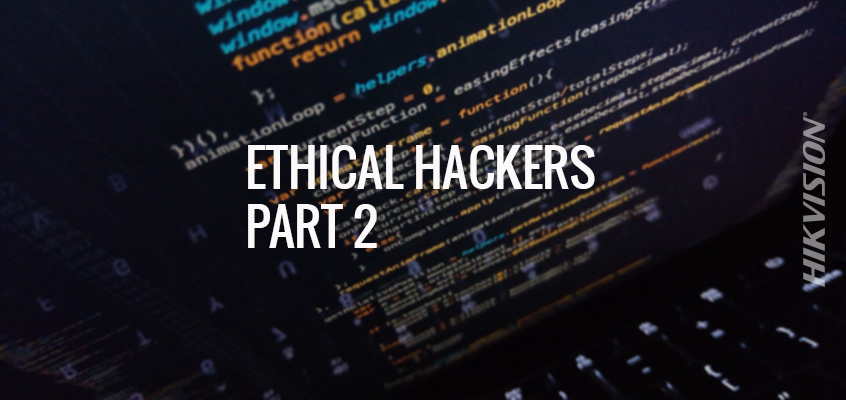Using Ethical Hackers to Help Your Company Uncover Vulnerabilities Part 2

Last week, in Part 1 of this blog series, we took a look at a Security magazine article about ethical hackers, examining reasons for hiring an ethical hacker and ways to recruit one. This week, we're delving into the definition of vulnerabilities in general, and in video surveillance in particular.
What are vulnerabilities?
Vulnerabilities are bugs or flaws in computer code that, when exploited, cause a negative impact to confidentiality, integrity, or availability (according to Mitre). We call this the "CIA triad." Vulnerabilities can be found in both software and firmware and are prevalent in most code. The more lines of code, the more likely there are vulnerabilities.
Vulnerabilities In Video Surveillance
It is important to understand that all devices on a network are computers. This includes IP-based video surveillance equipment and other IoT devices. Yes, your smart light bulbs are actually computers and most IP cameras and NVRs are Linux computers running a web server.
There are five indisputable facts we have to accept:
- All computers have vulnerabilities. Every month, your Windows, MacOS, Android, and iOS devices are sent security patches for newly discovered vulnerabilities.
- All IoT devices are computers: The Internet of Things (IoT) is a term use to reference all of the “things” that we now connect to the Internet, to make our lives easier and more convenient and make us feel more secure. Your smart light bulbs, smart refrigerator, smart thermostat, and anything else that you connect to your network, are actually computers. They have an operating system, network interface, memory, and storage.
- All IP-based video surveillance equipment are IoT devices: IP cameras and network-connected recording devices are part of the Internet of Things, as they are computers. In fact, the video camera that may be looking at you now is likely a Linux web server.
- All IP-based video surveillance equipment has vulnerabilities: It doesn’t matter who the manufacturer is, all of these devices have had, and will continue to have, vulnerabilities.
- Companies should not be judged on how many vulnerabilities they have. If that were the case, we wouldn’t be using any products from Microsoft, Apple, Google, or IBM, as they have some of the highest counts. Rather, companies should be judged on how quickly they fix the vulnerabilities, how they communicate those vulnerabilities and patches to customers and end users, and whether they responsibly disclose information.
The Responsible Disclosure Process
The responsible disclosure process is a generally accepted concept that is followed by most ethical hackers/security researchers and by software developers. While the general steps defined below can differ from company to company, these are the basics at a high level.
- Products are created, and despite all of the vulnerability scanning, code analysis, software security scanning and testing, it is arguably impossible to create code that does not contain vulnerabilities.
- Products are released to the public.
- Ethical hackers/security researchers decide to test the product. They use advanced tools, experience, and minds that loves to solve puzzles, to find ways to circumvent the security controls that are put in place.
- When a vulnerability is discovered, the ethical hacker/security researcher contacts only the software developer and reports what was found. They typically announce that the software developer has 90 days to patch or fix the vulnerability, or else the ethical hacker/security researcher will publicly disclose the vulnerability.
- The developer verifies the vulnerability and works with the researcher to understand and then patch or fix the vulnerability.
- On a predetermined date, the software developer discloses that there is a vulnerability by creating a CVE in the CVE database and announces that there is a patch to fix it. No details are shared with the public at this time. Typically, the ethical hacker also announces that they were the one who discovered the vulnerability.
- At this point, end users are given some time, usually 90 days, to patch their systems before the ethical hacker publicly release the details on how to exploit the vulnerability. When this happens, many of the malicious scanners that are constantly looking across the Internet for vulnerable systems, are updated to try and “hack” into unpatched devices.
To verify the above statements, let’s look to the globally accepted, de facto standard for disclosing vulnerabilities: the CVE database. You can access this at https://cve.mitre.org. Once there, just enter in the name of a company that makes software.
The author of the Security magazine article offers a few best practices for engaging hackers, which include:
- Ethical hackers are a community with a diverse skillset who focus on different types of vulnerabilities, so it’s important to clearly define the type of data you are trying to protect.
- Engage hackers with respect for what they do, and acknowledge them properly if a reported vulnerability is significant. According to the author, hackers want to be “paid for their time – or at least acknowledged for their contribution.”
- Provide a clear line of communication and assign a point person that hackers can reach out to. “As hackers, when we find a vulnerability, we search across the Internet to see which organizations might be affected. I once woke someone up at 3 a.m. to report a vulnerability that could have been a company shutdown event.”
Lastly, the article advises readers to remain in communication with the hacker after the vulnerability is reported. You’ll need to patch it first, then test to ensure it has been fixed, and finally re-engage the hacker to ensure the solution worked.
For companies engaging hackers for the first time, bug bounty platforms can support the process. For more about this and to read the entire article, click here.
